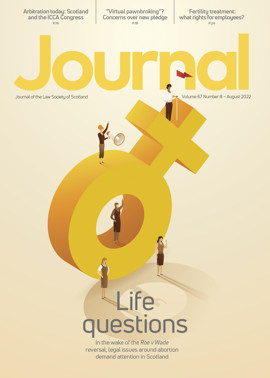Opinion: Mike Blair
The Scottish Government issued its consultation paper Land Reform in a Net Zero Nation in July. The proposals only deal slightly with “net zero” as such, but indicate a significant warming up of some of the land reform themes of recent years, based largely on evidence and papers by the Scottish Land Commission.
The paper is issued in advance of the expected Land Reform Bill, part of the SNP’s agreement for Government with the Scottish Green Party. Its major policy proposals are for:
- strengthening the Land Rights and Responsibilities Statement (“LRRS”);
- compulsory land management plans (“LMPs”);
- measures to regulate the market in “large-scale” landholdings (with a “public interest” test).
In addition, it proposes new conditions which would apply to public funding for land-based activity, and a new “land use tenancy” for tenant farmers. Reform of small landholdings
law is also mentioned, as is further action on transparency of ownership and control of land.
The proposals show a significant shift from the advice in the Land Commission paper of February 2021. The three main policy proposals only apply to what are referred to as “large-scale landholdings”, defined as those over 3,000 hectares in extent, or land accounting for more than a fixed percentage of a given area, or more than a minimum proportion of a permanently inhabited island. The paper seeks to avoid disproportionate duties on smaller scale landholdings or family farms; its proposals are intended to tackle the “issues associated with scale and concentration” of land ownership.
Regarding LRRS, the Commission, on a non-statutory basis, has issued “good practice protocols” advising how LRRS should be given effect, covering a variety of subjects, in particular engagement of local communities. A legal duty on land owners is now proposed, to comply with LRRS and its associated protocols; there would be a statutory process to adjudicate on complaints of non-compliance, which could be brought by organisations with community, charity or public service functions, with the possibility of recommendations or directions to the landowner and potentially financial penalties.
All large-scale landholdings would have to produce compulsory land management plans. The consultation lists what these should cover, and how they fit with the LRRS etc.
The purpose of the public interest test is to assess whether, on any transfer of a large-scale landholding, a risk would arise from the “creation or continuation of a situation in which excessive power acts against the public interest”. Differing from the Commission, the test would apply both to the seller and to the buyer who may already own land elsewhere. It is perhaps not unfair to say that the “public interest” is necessarily what the Government of the day thinks it is. The aim is to increase the opportunities of community groups to engage; there will not necessarily be interference in the sale. Prior notification of intention to sell is also proposed: there is a perception that off-market transactions exclude communities from getting involved.
The Land Commission’s 2021 paper takes further forward its 2019 report to ministers, published with its research review on “The effects associated with concentrated and large-scale land ownership in Scotland”. That report in turn, commentators have noted, relied on the responses to a public call for evidence without attempting to verify the information received, analysed in another Land Commission Paper. The major conclusion, however, was that there was no automatic link between large-scale landholdings and poor rural development outcomes, but convincing evidence that concentrated land ownership can cause problems.
Limited discussion of alternative mechanisms, such as using the planning system to influence “concentration” of ownership, appears in the consultation. Also, because almost all the 2019 evidence came from rural sources, there is only a nod to the relevance of this discussion to problems with concentrated ownership in urban Scotland, where most people live. The failure to focus on the Commission’s conclusion that concentration is more important than simple scale, suggests that the intended bill is at risk of missing the mark, in part at least.
The correct approach to “natural capital” forms part 12 of the consultation. Suggestions are sought for what the Government should do to use money from natural capital for both community and national benefit. This slightly begs the question as to how much money there will be, and more importantly over what period, arising out of activities to enhance natural capital, when public grants are factored in. For example, it might be “good for the planet” to cover Aberdeenshire in trees. That would mean making proper provision for people who now live there. If, however, in 2062, pests are destroying the new forests we may plant, what do we do and how do we pay?
It may be that nobody really yet knows what the cost and potential taxable surplus from natural capital activity will be over time.
Regulars
Perspectives
Features
Briefings
- Criminal court: Long road against addiction
- Family: CGT reforms in the pipeline
- Employment: Long COVID as a disability
- Human rights: civil rights not engaged by legal aid bid
- Pensions: A neverending story – fraud update
- Scottish Solicitors' Discipline Tribunal: August 2022
- Property: The RoS arrear: any light in the tunnel?
- In-house: As the workplace evolves







